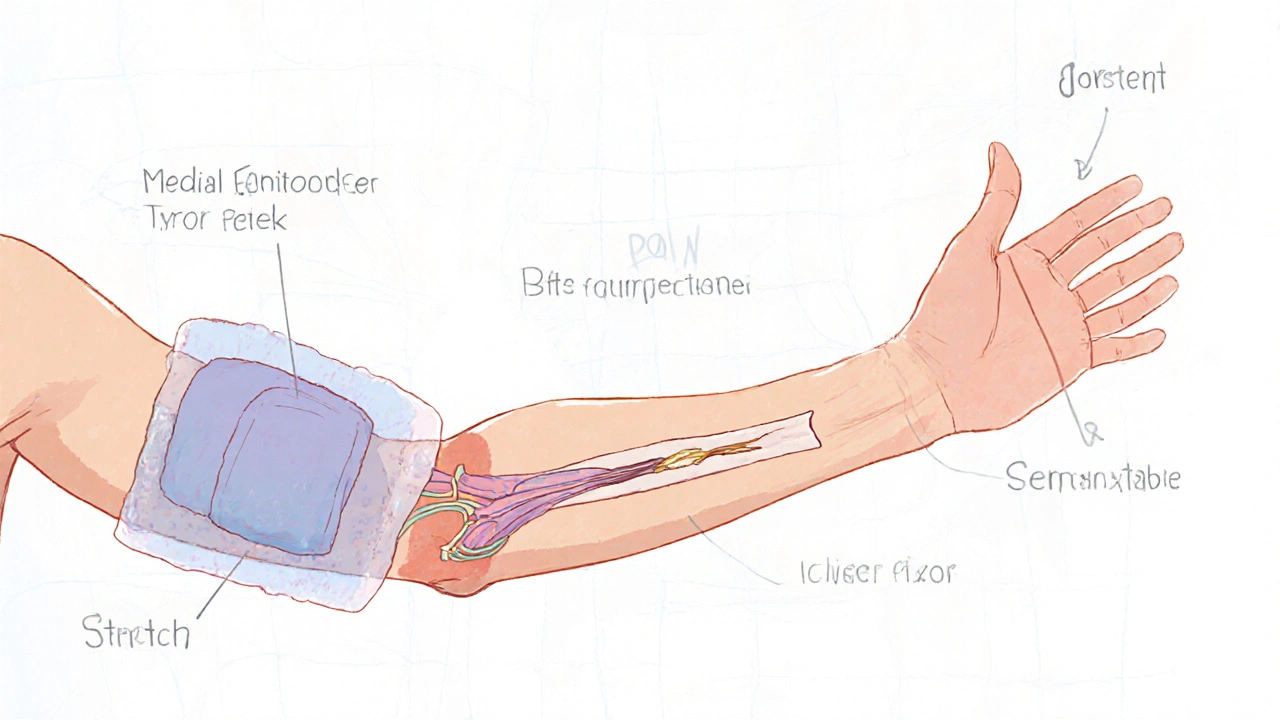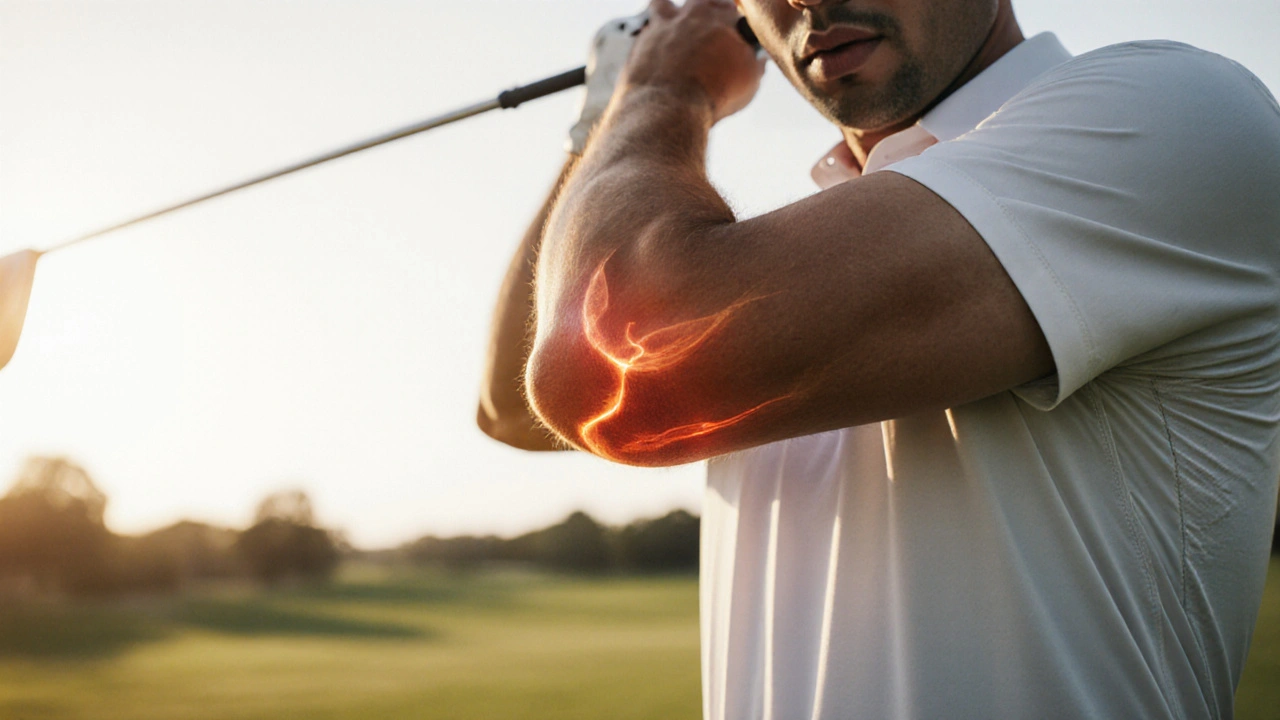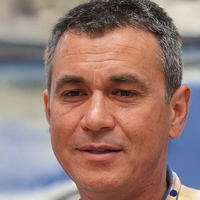Golfer's Elbow Symptom Checker
This symptom checker helps identify common signs of golfer's elbow. Remember, this is not a substitute for professional medical advice. If you're experiencing persistent elbow pain, consult a healthcare provider.
Your Symptom Analysis
Recommended Actions
Common Symptoms of Golfer's Elbow
Inner Elbow Pain
Pain localized to the inner side of the elbow
Grip Weakness
Difficulty holding objects firmly
Morning Stiffness
Stiffness that improves with movement
When your forearm starts hurting during a swing, you might blame the grip, the club, or even the weather. Often the real culprit is golfer's elbow, a form of tendonitis that targets the inner side of the elbow. Understanding why tendon inflammation builds up, how it shows up, and what you can actually do about it makes the difference between weeks of pain and getting back on the course.
Quick Takeaways
- Golfer’s elbow (medial epicondylitis) is tendonitis of the forearm flexor tendons.
- Typical symptoms include inner‑elbow pain, weakened grip, and stiffness after activity.
- Effective treatment starts with rest, ice, and targeted exercises; most people recover without surgery.
- Preventive measures such as grip adjustments, warm‑ups, and strength training cut recurrence by up to 70%.
- Seek medical advice if pain lasts more than 6weeks or if you notice loss of function.
Golfer’s elbow, also known as medial epicondylitis, is a type of tendonitis that affects the tendons attaching the forearm flexor muscles to the medial epicondyle of the humerus. While the name comes from the sport, the condition shows up in anyone who repeats wrist‑flexing motions - from tennis players to carpenters.
What Exactly Is Tendonitis?
Tendonitis is inflammation of a tendon, the thick cord that links muscle to bone. When a tendon is overloaded, tiny micro‑tears accumulate, triggering swelling and pain. In the case of golfer’s elbow, the forearm flexor tendons endure repeated tensile stress during the late swing phase, especially when the grip is too tight or the swing mechanics are off.
How Tendonitis Leads to Golfer’s Elbow
The chain of events looks like this:
- Excessive wrist flexion or forearm pronation creates repeated strain on the flexor tendons.
- Micro‑damage accumulates faster than the body can repair, causing inflammation.
- Swollen tendons thicken and lose elasticity, pulling on the medial epicondyle bone.
- The bone‑tendon interface becomes painful, especially during gripping or lifting.
Because the same tendons also help with everyday tasks (opening jars, shaking hands), the pain often spills over into daily life, not just the golf course.
Spotting the Symptoms
Typical signs include:
- A dull ache that intensifies when you grip a club, a racket, or even a coffee mug.
- Sharp pain during the last 30% of the swing, often described as a “stinging” sensation.
- Weakness in the hand; you may notice your grip slipping.
- Stiffness in the morning that eases after gentle movement.
If any of these symptoms linger beyond a few days, it’s worth a quick check‑up.

Diagnosing the Condition
Doctors usually start with a physical exam - feeling the medial epicondyle, asking you to perform resisted wrist flexion, and checking for tenderness. Imaging is rarely needed, but an ultrasound or MRI can confirm tendon thickness and rule out other issues such as ulnar nerve entrapment.
Conservative Treatment Options
Most cases resolve with non‑surgical care. The key steps are:
- Rest and activity modification: Cut back on high‑intensity swings for 1-2weeks. Substitute with low‑impact cardio.
- Ice therapy: Apply a cold pack for 15minutes, three times daily, to shrink swelling.
- Compression: A forearm sleeve provides gentle pressure and improves circulation.
- Physical therapy: Targeted exercises that stretch the flexor muscles and strengthen the extensor group help rebalance forces.
- Medications: Over‑the‑counter NSAIDs (ibuprofen, naproxen) reduce pain and inflammation when taken as directed.
When symptoms persist beyond six weeks, doctors may consider corticosteroid injections. These supply a powerful anti‑inflammatory burst, but they also carry a risk of tendon weakening if overused.
Advanced Therapies
For stubborn cases, newer modalities have shown promise:
- Platelet‑rich plasma (PRP) injections deliver growth factors directly to the damaged tendon, encouraging tissue repair.
- Extracorporeal shockwave therapy (ESWT) stimulates micro‑circulation, speeding up healing.
- Surgical release of the tendon attachment is a last resort, reserved for athletes who have exhausted all conservative paths.
Quick Comparison: Golfer’s Elbow vs. Tennis Elbow
| Aspect | Golfer’s Elbow (Medial) | Tennis Elbow (Lateral) |
|---|---|---|
| Primary tendons affected | Forearm flexor tendons | Forearm extensor tendons |
| Typical pain location | Inside of elbow | Outside of elbow |
| Common activities | Golf swing, weight lifting, throwing | Tennis backhand, painter’s brush, screwdriver use |
| Effective stretch | Wrist flexor stretch (palm up) | Wrist extensor stretch (palm down) |
| First‑line treatment | Rest, ice, forearm sleeve, flexor strengthening | Rest, ice, extensor strengthening |

Preventive Strategies to Keep the Elbow Happy
Prevention is about reducing repetitive strain and improving biomechanics. Try these simple habits:
- Warm‑up properly: Five minutes of light cardio followed by dynamic forearm stretches prepares the tendons.
- Check your grip size: Clubs that are too thin force the hand to over‑grip. A club‑fitting specialist can recommend the right shaft diameter.
- Focus on technique: Work with a coach to ensure the swing uses the hips and torso rather than over‑relying on the arms.
- Strengthen balanced muscles: Alternate flexor and extensor exercises (e.g., wrist curls vs. reverse wrist curls) keep the tendon forces even.
- Use supportive gear: A lightweight forearm strap can offload tension during long practice sessions.
Integrating these steps into weekly routines has been shown to cut re‑injury rates by roughly two‑thirds for amateur golfers.
When to See a Professional
Most tendinitis cases improve within six weeks of conservative care. However, seek a sports‑medicine physician or orthopedic specialist if you notice:
- Persistent pain beyond six weeks despite rest.
- Significant loss of grip strength that interferes with daily tasks.
- Numbness or tingling along the forearm, suggesting nerve involvement.
- Visible swelling or a palpable lump at the medial epicondyle.
Early intervention can prevent chronic changes that require surgery.
Next Steps & Troubleshooting
If you’ve tried rest and basic exercises but pain is still nagging, consider a short course of guided physical therapy. A therapist can assess your swing mechanics with video analysis and prescribe a custom exercise plan. Should the pain flare up after a return to play, dial back the intensity for a few days and repeat the stretch‑strength cycle before pushing harder again.
Frequently Asked Questions
Is golfer’s elbow the same as tendonitis?
Golfer’s elbow is a specific type of tendonitis that affects the flexor tendons on the inside of the elbow. Not all tendonitis occurs there, but all golfer’s elbow cases involve tendon inflammation.
Can I still play golf while recovering?
Light practice without full swings is usually fine. Focus on short chips and putts, and avoid the late‑drive motion that stresses the flexors. If pain spikes, stop and rest.
How long does it take to heal?
Most people see improvement within 4-6 weeks with proper care. Full recovery, especially for competitive athletes, can take 2-3 months.
Are corticosteroid shots safe?
They’re effective for short‑term pain relief but should be limited to one or two injections because repeated use may weaken the tendon and increase rupture risk.
What’s the best grip size for preventing elbow pain?
A grip that fits comfortably without forcing a tight hold is ideal. Most golfers benefit from a grip size that allows the lead hand’s thumb to rest lightly on the shaft’s top edge.





October 7, 2025 AT 15:23 PM
The article tries to sound scientific but ends up peppering buzzwords without real depth. Most readers need clear, actionable steps, not a laundry list of vague recommendations. Consider trimming the fluff and focusing on evidence‑based protocols.
October 9, 2025 AT 22:35 PM
I totally get how frustrating golfer's elbow can be 😔. Taking it slow and following the rehab plan can really make a difference. Keep an eye on your grip and listen to your body.
October 12, 2025 AT 05:47 AM
Honestly, this reads like a copy paste from some generic health site, y'know? It's all over the place and I could do with a bit more real world tips. Maybe a video would help, lol.
October 14, 2025 AT 12:59 PM
Sounds like a solid overview, especially the part about balancing flexor and extensor work. I've found dynamic warm‑ups before a round make a big difference.
October 16, 2025 AT 20:11 PM
From a biomechanical perspective, the repetitive pronation‑supination cycle imposes tensile overload on the common flexor origin, precipitating micro‑tears and subsequent inflammatory cascade. Targeted eccentric loading can mitigate this stress.
October 19, 2025 AT 03:23 AM
We shouldn't ignore the fact that many athletes push through pain for profit, compromising long‑term joint health.
October 21, 2025 AT 10:35 AM
So let me get this straight: you spend hours swinging a club, then blame the very motion you love for a little ache.
Your elbow, apparently, decided to file a formal complaint and now you’re stuck with medical jargon.
The article dutifully lists rest, ice, and compression as if they’re novel inventions.
In reality, everyone knows you can’t outrun inflammation by sheer willpower.
What’s more amusing is the suggestion that a forearm sleeve will magically cancel out years of overuse.
If you’re still reading, you probably think a quick stretch will miraculously reverse tendon degeneration.
Spoiler: tendons don’t rebuild themselves overnight.
You’ll need consistent eccentric loading, progressive overload, and patience.
Skipping the proper protocol because you’re ‘busy’ just guarantees a longer recovery.
And let’s not forget the hidden cost of repetitive strain on your overall kinetic chain.
A weak forearm can lead to compensations in the shoulder, back, and even the hips.
So the ‘quick fix’ narrative is not only unrealistic, it’s dangerous.
If you truly want to get back on the course, invest time in targeted physiotherapy.
Consider consulting a certified sports therapist who can tailor a program to your specific swing mechanics.
Otherwise, you’ll keep chasing that elusive “pain‑free” swing and end up with chronic issues.
October 23, 2025 AT 17:47 PM
A simple grip adjustment can reduce the load on the forearm flexors.
October 26, 2025 AT 00:59 AM
Enough said.
October 28, 2025 AT 08:11 AM
Stay positive, take it one day at a time, and you’ll be back swinging soon!
October 30, 2025 AT 15:23 PM
According to current orthopedic literature, medial epicondylitis prevalence among recreational golfers ranges between 5% and 12%, underscoring the necessity of preventive conditioning.
November 1, 2025 AT 22:35 PM
While the sarcasm hits the mark, the practical advice remains vital: integrate eccentric wrist flexor exercises, such as the reverse roller, into your weekly regimen and monitor load progression meticulously.
November 4, 2025 AT 05:47 AM
Eccentric training only works if you already have a solid baseline of strength, otherwise you risk further injury.
November 6, 2025 AT 12:59 PM
Great stats! 📊 Just remember numbers don’t replace feeling the burn in your own arm during practice.
November 8, 2025 AT 20:11 PM
Our country’s sports programs should prioritize injury education, not just performance metrics.
November 11, 2025 AT 03:23 AM
Believe in your capacity to heal; start with gentle wrist flexor stretches, then gradually add resistance. Consistency beats intensity.
November 13, 2025 AT 10:35 AM
You’d think they’d mention how corporate sponsorships push athletes to ignore pain for profit, but the article stays blissfully naïve.
November 15, 2025 AT 17:47 PM
Could you elaborate on the recommended frequency for forearm sleeves during training sessions? I’m curious about the balance between support and muscle activation.
November 18, 2025 AT 00:59 AM
Some players swear by acupuncture for tendon issues, though evidence remains anecdotal at best.
November 20, 2025 AT 08:11 AM
In summary proper rehab includes rest ice compression elevation and progressive loading but avoid overreliance on steroids